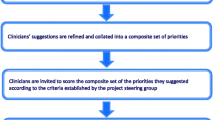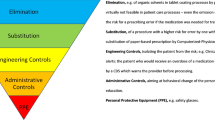Abstract
Background While evidence on implementation of medication safety strategies is increasing, reasons for selecting and relinquishing distinct strategies and details on implementation are typically not shared in published literature. Objective We aimed to collect and structure expert information resulting from implementing medication safety strategies to provide advice for decision-makers. Setting Medication safety experts with clinical expertise from thirteen hospitals throughout twelve European and North American countries shared their experience in workshop meetings, on-site-visits and remote structured interviews. Methods We performed an expert-based, in-depth assessment of implementation of best-practice strategies to improve drug prescribing and drug administration. Main outcome measures Workflow, variability and recommended medication safety strategies in drug prescribing and drug administration processes. Results According to the experts, institutions chose strategies that targeted process steps known to be particularly error-prone in the respective setting. Often, the selection was channeled by local constraints such as the e-health equipment and critically modulated by national context factors. In our study, the experts favored electronic prescribing with clinical decision support and medication reconciliation as most promising interventions. They agreed that self-assessment and introduction of medication safety boards were crucial to satisfy the setting-specific differences and foster successful implementation. Conclusion While general evidence for implementation of strategies to improve medication safety exists, successful selection and adaptation of a distinct strategy requires a thorough knowledge of the institute-specific constraints and an ongoing monitoring and adjustment of the implemented measures.


Similar content being viewed by others
References
Kohn L, Corrigan J, Donaldson M, editors. Committee on Quality of Health Care in America, Institute of Medicine. To err is human—building a safer health care system. Washington: National Academies Press; 1999.
Lisby M, Nielsen LP, Brock B, Mainz J. How are medication errors defined? A systematic literature review of definitions and characteristics. Int J Qual Health Care. 2010;22:507–18.
Aarts J, Berg M. A tale of two hospitals: a sociotechnical appraisal of the introduction of computerized physician order entry in two Dutch hospitals. Stud Health Technol Inform. 2004;107(Pt 2):999–1002.
Greengold NL, Shane R, Schneider P, Flynn E, Elashoff J, Hoying CL, et al. The impact of dedicated medication nurses on the medication administration error rate: a randomized controlled trial. Arch Intern Med. 2003;163:2359–67.
Shekelle PG, Pronovost PJ, Wachter RM, Taylor SL, Dy SM, Foy R, et al. Advancing the science of patient safety. Ann Intern Med. 2011;154:693–6.
Kawamoto K, Houlihan CA, Balas EA, Lobach DF. Improving clinical practice using clinical decision support systems: a systematic review of trials to identify features critical to success. BMJ. 2005;330:765.
Sittig DF, Stead WW. Computer-based physician order entry: the state of the art. J Am Med Inform Assoc. 1994;1:108–23.
Han YY, Carcillo JA, Venkataraman ST, Clark RS, Watson RS, Nguyen TC, et al. Unexpected increased mortality after implementation of a commercially sold computerized physician order entry system. Pediatrics. 2005;116:1506–12.
Peikari HR, Zakaria MS, Yasin NM, Shah MH, Elhissi A. Role of computerized physician order entry usability in the reduction of prescribing errors. Healthc Inform Res. 2013;19:93–101.
Institute of Medicine: Consensus Report: Preventing Medication Errors. http://www.iom.edu/Reports/2006/Preventing-Medication-Errors-Quality-Chasm-Series.aspx. Last Accessed 7 Sept 2015.
Agency for Healthcare Research. Making Health Care Safer II. http://www.ahrq.gov/sites/default/files/wysiwyg/research/findings/evidence-based-reports/services/quality/ptsafetyII-full.pdf. Last Accessed 7 Sept 2015.
National Quality Forum (NQF). Safe practices for better healthcare—2010 update: a consensus report. Washington: NQF; 2010.
Leape LL, Bates DW, Cullen DJ, Cooper J, Demonaco HJ, Gallivan T, et al. Systems analysis of adverse drug events: ADE Prevention Study Group. JAMA. 1995;274:35–43.
Ishikawa K. Introduction to quality control. 3rd ed. New York: Quality Resources; 1990.
Benn J, Burnett S, Parand A, Pinto A, Vincent C. Factors predicting change in hospital safety climate and capability in a multi-site patient safety collaborative: a longitudinal survey study. BMJ Qual Saf. 2012;21:559–68.
McFadden KL, Stock GN, Gowen CR 3rd. Leadership, safety climate, and continuous quality improvement: impact on process quality and patient safety. J Nurs Adm. 2014;44:S27–37.
Redwood S, Ngwenya NB, Hodson J, Ferner RE, Coleman JJ. Effects of a computerized feedback intervention on safety performance by junior doctors: results from a randomized mixed method study. BMC Med Inform Decis Mak. 2013;13:63.
Padilla-Marín V, Corral-Baena S, Domínguez-Guerrero F, Santos-Rubio MD, Santana-López V, Moreno-Campoy E. ISMP-Spain questionnaire and strategy for improving good medication practices in the Andalusian health system. Farm Hosp. 2012;36:374–84.
Bonnabry P, Despont-Gros C, Grauser D, Casez P, Despond M, Pugin D, et al. A risk analysis method to evaluate the impact of a computerized provider order entry system on patient safety. J Am Med Inform Assoc. 2008;15:453–60.
ISMP® Medication Self Assessment® for Hospitals. http://www.ismp.org/survey/default.asp. Last Accessed 7 Sept 2015.
French Agency for Hospitals’ performance (ANAP). Tool—assessment and management of risks related to medication process. http://www.anap.fr/publications-et-outils/outils/detail/actualites/evaluer-et-gerer-les-risques-lies-a-la-prise-en-charge-medicamenteuse-en-etablissement-de-sante-1/. Last Accessed 7 Sept 2015.
Poon EG, Keohane CA, Yoon CS, Ditmore M, Bane A, Levtzion-Korach O, et al. Effect of bar-code technology on the safety of medication administration. N Engl J Med. 2010;362:1698–707.
Patton MQ. Qualitative evaluation and research methods. 2nd ed. Newbury Park: Sage; 1990.
Pintor-Mármol A, Baena MI, Fajardo PC, Sabater-Hernández D, Sáez-Benito L, García-Cárdenas MV, et al. Terms used in patient safety related to medication: a literature review. Pharmacoepidemiol Drug Saf. 2012;21:799–809.
Acknowledgments
The authors wish to thank all participating experts and their respective institutions for their greatly appreciated support and efforts in this assessment, particularly the consultant experts (Blanca Argüello, Hospital de Leon, Leon, Spain; Laila Irene Bruun, Oslo University Hospitals, Oslo, Norway; Birgit Eiermann, Karolinska Institutet, Department of Laboratory Medicine, Division of Clinical Pharmacology, Stockholm, Sweden; Annsofie Fyhr, Pharmaceutical Supply, Operational Support and Service, Jönköping County Council, Sweden; Allen R. Huang, McGill University Health Centre, Montreal, Canada; Karin Dorner, Allgemeines Krankenhaus der Stadt Wien, Vienna, Austria; Lilian Brøndgaard Nielsen, Hospital Pharmacy Central Denmark Region, Horsens, Denmark; Juan Ortiz de Urbina, Hospital de Leon, Leon, Spain; Diane Seger, Brigham and Women’s Hospital, Boston, USA; Anne Marie Timenes, Oslo University Hospitals, Oslo, Norway).
Funding
The study was supported by the Federal Ministry of Health, Germany [#2512 ATS 002] and a final report in German is available online.
Author information
Authors and Affiliations
Corresponding author
Ethics declarations
Conflicts of interest
The authors declare that they have no competing interests with regard to this work.
Electronic supplementary material
Below is the link to the electronic supplementary material.
Rights and permissions
About this article
Cite this article
Seidling, H.M., Stützle, M., Hoppe-Tichy, T. et al. Best practice strategies to safeguard drug prescribing and drug administration: an anthology of expert views and opinions. Int J Clin Pharm 38, 362–373 (2016). https://doi.org/10.1007/s11096-016-0253-1
Received:
Accepted:
Published:
Issue Date:
DOI: https://doi.org/10.1007/s11096-016-0253-1




